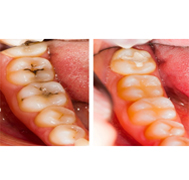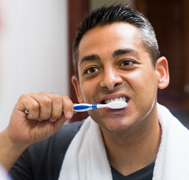
Tooth Extraction
-

What Is It?
Tooth extraction is the removal of a tooth from its socket in the bone.
What It's Used For
If a tooth has been broken or damaged by decay, your dentist will try to fix it with a filling, crown or other treatment. Sometimes, though, there's too much damage for the tooth to be repaired. In this case, the tooth needs to be extracted. A very loose tooth also will require extraction if it can't be saved, even with bone replacement surgery (bone graft).
The most common reason for extraction is tooth damage due to breakage or decay. There are additional reasons for tooth extraction:
- Severe tooth decay or infection (acute or chronic alveolar abscess). Despite the reduction in worldwide prevalence of dental caries, it is still the most common reason for extraction of (non-third molar) teeth with up to two thirds of extractions.
- Supernumerary teeth which are blocking other teeth from coming in
- Severe gum disease which may affect the supporting tissues and bone structures of teeth
- In preparation for orthodontic treatment (braces)
- Teeth in the fracture line
- Teeth which cannot be restored endodontically
- Fractured teeth
- Supernumerary, supplementary or malformed teeth
- Prosthetics; teeth detrimental to the fit or appearance of dentures
- Treatment of symptomatic impacted wisdom teeth, whose impaction is causing pathosis that will lead to yet more (infection, inflammation, bone resorption)
- Cosmetic - to remove teeth of poor appearance, unsuitable for restoration
- Head and neck radiation therapy, to treat and/or manage tumors, may require extraction of teeth, either before or after radiation treatments
- Deliberate, medically unnecessary, extraction as a form of physical torture.
- Reduced cost compared to other treatments
Types
There are two types of extractions – simple and surgical. Simple extractions are performed by loosening the tooth and removing it with forceps.Alternatively, surgical extractions are performed by making an incision into the gum and removing the tooth. Basically, the patient should feel only pressure, but no pain during the treatment. If stitches are necessary, usually the dental surgeon will use dissoluble stitches.
What to Expect With Tooth Extraction
Dentists and oral surgeons (dentists with special training to perform surgery) perform tooth extractions. Before pulling the tooth, your dentist will give you an injection of a local anesthetic to numb the area where the tooth will be removed If the tooth is impacted, the dentist will cut away gum and bone tissue that cover the tooth and then, using forceps, grasp the tooth and gently rock it back and forth to loosen it from the jaw bone and ligaments that hold it in place. Sometimes, a hard-to-pull tooth must be removed in pieces.
Once the tooth has been pulled, a blood clot usually forms in the socket. The dentist will pack a gauze pad into the socket and have you bite down on it to help stop the bleeding. Sometimes the dentist will place a few stitches -- usually self-dissolving -- to close the gum edges over the extraction site.
Sometimes, the blood clot in the socket breaks loose, exposing the bone in the socket. This is a painful condition called dry socket. If this happens, your dentist will likely place a sedative dressing over the socket for a few days to protect it as a new clot forms.
After You've Had a Tooth Pulled
Following an extraction, your dentist will send you home to recover. Recovery typically takes a few days. The following can help minimize discomfort, reduce the risk of infection, and speed recovery.
- Take anti pain medications as prescribed.
- Bite firmly but gently on the gauze pad placed by your dentist to reduce bleeding and allow a clot to form in the tooth socket. Change gauze pads before they become soaked with blood. Otherwise, leave the pad in place for three to four hours after the extraction.
- Apply an ice bag to the affected area immediately after the procedure to keep down swelling. Apply ice for 10 minutes at a time.
- Relax for at least 24 hours after the extraction. Limit activity for the next day or two.
- Avoid rinsing or spitting forcefully for 24 hours after the extraction to avoid dislodging the clot that forms in the socket.
- After 24 hours, rinse with your mouth with a solution made of 1/2 teaspoon salt and 8 ounces of warm water.
- Do not drink from a straw for the first 24 hours.
- Do not smoke, which can inhibit healing.
- Eat soft foods, such as soup, pudding, yogurt, or applesauce the day after the extraction. Gradually add solid foods to your diet as the extraction site heals.
- When lying down, prop your head with pillows. Lying flat may prolong bleeding.
- Continue to brush and floss your teeth, and brush your tongue, but be sure to avoid the extraction site. Doing so will help prevent infection.
When to Call the Dentist
It is normal to feel some pain after the anesthesia wears off. For 24 hours after having a tooth pulled, you should also expect some swelling and residual bleeding. However, if either bleeding or pain is still severe more than four hours after your tooth is pulled, you should call your dentist. You should also call your dentist if you experience any of the following:
- Signs of infection, including fever and chills
- Nausea or vomiting
- Redness, swelling, or excessive discharge from the affected area
- Cough, shortness of breath, chest pain, or severe nausea or vomiting
The initial healing period usually takes about one to two weeks. New bone and gum tissue will grow into the gap. Over time, however, having a tooth (or teeth) missing can cause the remaining teeth to shift, affecting your bite and making it difficult to chew. For that reason, your dentist may advise replacing the missing tooth or teeth with an implant, fixed bridge, or denture.At Bright Smile, we are proud to be one of the best Dental Clinic with utmost care using the advanced technology and we have a team of best Dentists in Dubai to ensure safe and best oral health for our patients. Be it tooth extraction / tooth removal / tooth filling service you can rely on us.
So if you would like to consult a dentist for your tooth removal service or tooth extraction and filling services, just call us and meet us to take care of your oral health.

Hearing strange noises and having someone work inside your mouth can understandably cause a lot of stress and anxiety. But not to worry, we’re here to tell you exactly what will be going on from start to finish the next time you visit your dentist for a routine checkup. After all, the more you know about something, the less scary it seems!
read more...

A filling is a proedure to restore a tooth damaged by decay back to its normal function and shape. When a dentist gives you a filling, he or she first removes the decayed tooth material, cleans the affected area, and then fills the cleaned out cavity with a filling material.
read more...
Dental cleanings involve removing plaque (soft, sticky, bacteria infested film) and tartar (calculus) deposits that have built up on the teeth over time. Your teeth are continually soaked in saliva which contains calcium and other substances which help strengthen and protect the teeth.
read more...
Contact Us/ Send an Enquiry Click Here
Bright Smile Center
Bright Smile Dental & Orthodontic Center,
Al Shafar Bldg 7,
Jumeirah One,
Al Wasl Road,
Unit #105, Dubai - UAE,
PO Box 252189,
Tel : +971 4 344 9675
Fax: +971 4 344 9657
Email: info@brightsmile.ae
Our area is next to the famous city walk. It is the same building of 2XL Furniture, located between Life Pharmacy and Aswaq Supermarket, and opposite of Emarat Petrol Station.
Working Hours
Saturday to Wednesday
10:00am – 20:00pm
Thursday
10:00am – 18:00pm
(Friday Closed)

 English
English  العربية
العربية 



